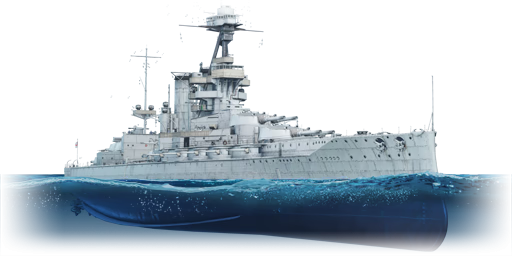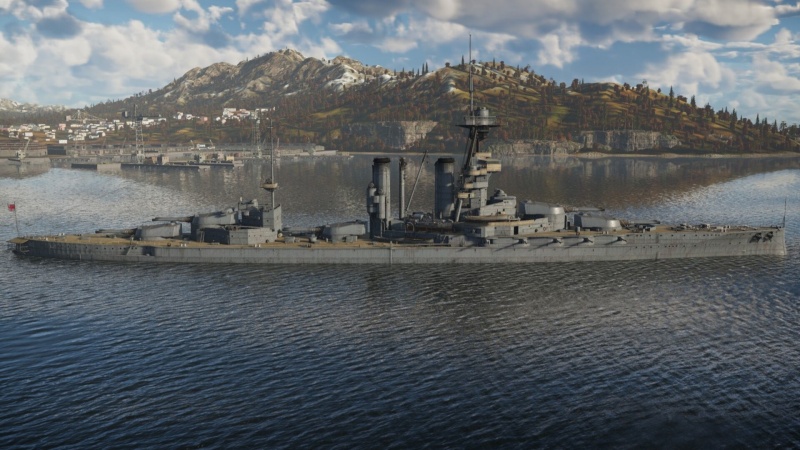HMS Marlborough
Contents
Description
The Iron Duke-class, HMS Marlborough (66), 1927 is a rank VI British battleship with a battle rating of 6.7 (AB/RB/SB). It was introduced in Update "New Power".
General info
Survivability and armour
Talk about the vehicle's armour. Note the most well-defended and most vulnerable zones, e.g. the ammo magazine. Evaluate the composition of components and assemblies responsible for movement and manoeuvrability. Evaluate the survivability of the primary and secondary armaments separately. Don't forget to mention the size of the crew, which plays an important role in fleet mechanics. Save tips on preserving survivability for the "Usage in battles" section. If necessary, use a graphical template to show the most well-protected or most vulnerable points in the armour.
Mobility
Write about the ship's mobility. Evaluate its power and manoeuvrability, rudder rerouting speed, stopping speed at full tilt, with its maximum forward and reverse speed.
| Mobility Characteristics | |||
|---|---|---|---|
| Game Mode | Upgrade Status | Maximum Speed (km/h) | |
| Forward | Reverse | ||
| AB | |||
| Upgraded | 47 | 28 | |
| RB/SB | |||
| Upgraded | 41 | 24 | |
Modifications and economy
Armament
Primary armament
Provide information about the characteristics of the primary armament. Evaluate their efficacy in battle based on their reload speed, ballistics and the capacity of their shells. Add a link to the main article about the weapon: {{main|Weapon name (calibre)}}. Broadly describe the ammunition available for the primary armament, and provide recommendations on how to use it and which ammunition to choose.
Secondary armament
Some ships are fitted with weapons of various calibres. Secondary armaments are defined as weapons chosen with the control Select secondary weapon. Evaluate the secondary armaments and give advice on how to use them. Describe the ammunition available for the secondary armament. Provide recommendations on how to use them and which ammunition to choose. Remember that any anti-air armament, even heavy calibre weapons, belong in the next section. If there is no secondary armament, remove this section.
Anti-aircraft armament
An important part of the ship's armament responsible for air defence. Anti-aircraft armament is defined by the weapon chosen with the control Select anti-aircraft weapons. Talk about the ship's anti-air cannons and machine guns, the number of guns and their positions, their effective range, and about their overall effectiveness – including against surface targets. If there are no anti-aircraft armaments, remove this section.
Additional armament
Describe the available additional armaments of the ship: depth charges, mines, torpedoes. Talk about their positions, available ammunition and launch features such as dead zones of torpedoes. If there is no additional armament, remove this section.
Usage in battles
Describe the technique of using this ship, the characteristics of her use in a team and tips on strategy. Abstain from writing an entire guide – don't try to provide a single point of view, but give the reader food for thought. Talk about the most dangerous opponents for this vehicle and provide recommendations on fighting them. If necessary, note the specifics of playing with this vehicle in various modes (AB, RB, SB).
Pros and cons
Pros:
Cons:
History
Devblog
Designed under the 1911 build program, the Iron Duke class of British super dreadnoughts were considered repeats of the preceding King George V class, but featured a reinforced to 6 inch (152mm) secondary battery and improved protection. HMS Marlborough was the second of four ships of this class to be laid down in January 1912, following HMS Iron Duke - the lead ship of the class. HMS Marlborough was launched in October of the same year and subsequently entered service with the Royal Navy in June 1914, just prior to the outbreak of The Great War.
During WWI, HMS Marlborough faced her most fierce engagement during the Battle of Jutland in 1916. Throughout the battle, HMS Marlborough fired off more than 160 primary battery shells, the most from the battleships of the Grand Fleet’s main forces in this battle. In return however, HMS Marlborough also suffered heavy damage from a torpedo launched by a German warship. As a result of the damage, HMS Marlborough was returned to drydock for extended repairs for several months before rejoining the ranks of the Grand Fleet.
In the remaining two years of the war, HMS Marlborough didn’t participate in any large operations. After the war however, the battleship took part in the Russian Civil War against the Bolsheviks and evacuated Russian nobility and civilians from Yalta.
After the signing of the London Naval Treaty, HMS Marlborough was destined for scrapping. However, before the ship could meet its fate in 1932, HMS Marlborough was used extensively as a test ship on which several weapons tests were carried out, the results of which helped shape the design of subsequent British capital ships.
Media
See also
Links to articles on the War Thunder Wiki that you think will be useful for the reader, for example:
- reference to the series of the ship;
- links to approximate analogues of other nations and research trees.
External links
Citations
Bibliography
| Britain battleships | |
|---|---|
| HMS Dreadnought* | |
| Colossus-class | HMS Colossus |
| Orion-class | HMS Orion |
| Iron Duke-class | HMS Iron Duke · HMS Marlborough |
| Queen Elizabeth-class | HMS Barham |
| * Unique ship | |





